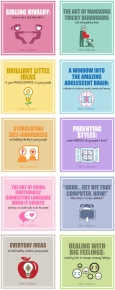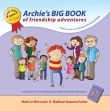Chapter Five:
Friendships and Bullying
Creating friendshipsThe kinds of friends and relationships your children develop when they are young have a lot to say about how they will behave, the type of people they will become and the sorts of relationships they will seek later in life. As a parent, you provide the simple everyday influences that contribute most to how children feel about themselves and about others.
A healthy beginning is to examine your own attitude on the topic of friendship. Think about your own style of friendship building, how do you do it? What works for you? Do other adults do it the same way as you? Are there similarities in the way your child's friendships and your own friendship patterns work? You see, some parents believe their child needs "a best friend," because they had one, and they hold precious memories of growing up with a best friend. Yet the truth is that children's friendships are truly impetuous and ever changing. Leading a child to expect "a best friend" to come along or to believe that most children have "a best friend" can be a devastating half-truth. Of far greater value is to encourage children to see the natural fluidity of relationships. To encourage them to listen, participate, express their feelings to their friends, enjoy relationships and accept the inevitable changes. As we all know, little else is more certain than changes in friendship!
Quite often, I meet sensible, caring parents who are troubled by their child's poor friendship making abilities. They explain that their child seems to fl oat between groups, appears to socialise on the edge of a group and is rarely invited to outings, sleepovers and parties which leaves them feeling unsatisfied. I frequently hear, "All I want is for my child to be happy." A few become so worried about their child's social connections that they spend a lot of time manipulating their social contacts. Over time their children tire of the monotony of their questions; "Why don't you call Joel and Sim and go to the movies? It would be fun." And "Who did you play with today?" Or, "Was anyone mean to you today." It doesn't take long before children realise their parent's questions are actually masked by apprehension and a lack of confidence in their performance.
Bullying and how to deal with it
Over the last few years researchers have collected enormous amounts of information about bullying. Consequently, we now know that no kindergarten, school or college is free from bullying and no student can be guaranteed safety from it. Australian bully researcher, Ken Rigby, tells us that one out of six students is bullied in each Australian school each week, and this figure is high by world standards. The general profile of a bully is near impossible to define. Some bullies are obvious hateful brutes, others are socially inept and some bully "ever so sweetly" to get their way. Research confirms that absenteeism is greater among those who are bullied. In addition, students being bullied were found to be associated with suicidal thoughts and attempts to harm themselves. As a response to counter bullying behaviours we have seen plenty of policies and programs implemented in schools. While the media is always quick to pick up, talk up and popularise these programs they have, unfortunately, yielded only average improvements.
Countering bullying begins at home
Naturally, it isn't possible to isolate your child from bullying encounters, but it is possible to take a few practical steps to sharpen their awareness and responses to this unwanted behaviour.
1. Teach your child what bullying behaviours are
Teach that bullying is all about the manipulative overuse of power and your child's response to it can reward the bully's behaviour, deflate it or deflect it. Be sure to lead your child to recognise the difference between bullying and not being able to get their own way over something. There is a world of difference!
All book purchases include a one off $20 postage and handling fee per purchase












